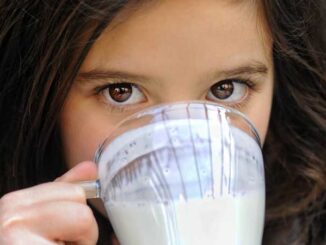
First and foremost, it is vital to note that milk Kefir is often thinner than yogurt, and you should never anticipate it to be as solid and thick as Greek yogurt. Milk Kefir has a typical density similar to that of slightly diluted yogurt.
However, even after 12 or more hours of fermentation, the thickness of milk Kefir can stay nearly identical to that of fresh milk. What could be the cause behind this?
There are various reasons why milk kefir does not thicken. Kefir is a fermented dairy product derived from kefir grains, which contain bacteria and yeast. The fermentation process, as well as numerous other elements, influence the thickness of Kefir.
Here are some typical reasons why milk Kefir doesn’t reach the desired thickness:
Temperature
Kefir ferments best at room temperature (around 68-78°F or 20-26°C). If the temperature is too low, the fermentation process may slow down, resulting in thinner Kefir.
Time
Kefir needs adequate time to ferment. If you don’t allow it to ferment long enough, it may remain thin. Typically, Kefir is left to ferment for 24-48 hours, but the exact time can vary depending on the temperature and the strength of your kefir grains.
Kefir grains
The health and activity of your kefir grains can affect the thickness of the final product. If your kefir grains are weakened or not enough active, they may not produce the desired thickness. You may need to rejuvenate or replace your kefir grains.
Milk type
The type of milk used can also impact Kefir’s thickness. Whole milk tends to produce thicker Kefir compared to skim or low-fat milk. Using different milk varieties or brands can yield varying results.
Overcrowding
Having too many kefir grains in a small amount of milk can lead to thin Kefir. Ensure that you have an appropriate ratio of kefir grains to milk volume. Usually, a tablespoon of kefir grains for every cup of milk is a good starting point.
Hygiene
Proper hygiene is essential when handling kefir grains. Make sure your equipment and containers are clean and free of any residues that might inhibit fermentation.
Inadequate aeration
Kefir needs oxygen to ferment properly. Ensure that you cover your kefir container with a breathable cloth or lid with small holes to allow air circulation. Airtight containers can hinder fermentation.
Inconsistent fermentation conditions
Changes in temperature or other environmental factors during fermentation can affect the final consistency of Kefir. Try to maintain a stable environment for consistent results.
Initial activation
If you’re using new or previously dormant kefir grains, they may take some time to activate and achieve their full fermenting capacity. Be patient and give them a few batches to reach peak conditions.
If you’ve addressed these concerns and your kefir still isn’t thickening, you might want to consult with an expert Kefir maker or consider replacing your kefir grains if they’re constantly producing thin Kefir even under ideal conditions.
Alternatively, please have a look at our following advice on how to achieve a thicker milk Kefir:
How to make milk Kefir thicker and less watery?
If your milk Kefir is consistently thin and you want to make it thicker, there are several steps you can take to achieve a thicker consistency:
Use Whole Milk
Whole milk contains more fat than skim or low-fat milk, and this extra fat can contribute to a thicker Kefir. Consider using whole cow’s milk, goat’s milk, or other full-fat milk options.
Adjust Milk-to-Grain Ratio
Increasing the ratio of milk to kefir grains can result in a thicker Kefir. Use a higher amount of milk for a given quantity of kefir grains.
Fermentation Time
Allowing kefir to ferment for a longer period can lead to a thicker consistency. Experiment with longer fermentation times, but be cautious not to over-ferment, as this can result in overly sour Kefir.
Optimal Fermentation Temperature
Ensure that the fermentation takes place at the ideal temperature range, typically around 68-78°F (20-26°C). Cooler temperatures may slow down fermentation, while warmer temperatures may produce thinner Kefir.
Agitate or Stir During Fermentation
Gently stir or agitate the Kefir during fermentation to distribute the kefir grains evenly. This can help in achieving a more consistent thickness, as when stirring, more grains will be in constant contact with fresh milk.
Choose Active and Healthy Grains
Ensure that your kefir grains are active and healthy. If they’ve been sitting unused for a while, consider activating them in fresh milk for a few batches to revitalize their fermentation potential.
Strain and Thicken
After the initial fermentation, strain the Kefir to separate the grains from the liquid. Allow the strained Kefir to sit for a few additional hours at room temperature to thicken further before refrigerating.
Add Thickening Agents
If you’re still struggling to achieve the desired thickness, you can experiment with adding thickeners like powdered milk, gelatin, or pectin to the Kefir before fermentation. Start with small amounts and adjust based on your preferences.
Use Second Fermentation
After straining the kefir grains, you can opt for a second fermentation with fruits, sweeteners, or other flavorings. This can add thickness and flavor to your kefir.
Blend or Mix
If you prefer a creamier texture, you can blend the strained Kefir with fruits or yogurt to achieve a thicker consistency.
Remember that the thickness of Kefir might vary naturally depending on temperature, fermentation period, and the individual strain of kefir grains you’re using. It may take some experimenting to obtain the ideal mix for your taste preferences. Furthermore, be patient and give these alterations a few batches to observe the desired benefits, as Kefir can be very sensitive to environmental changes.



